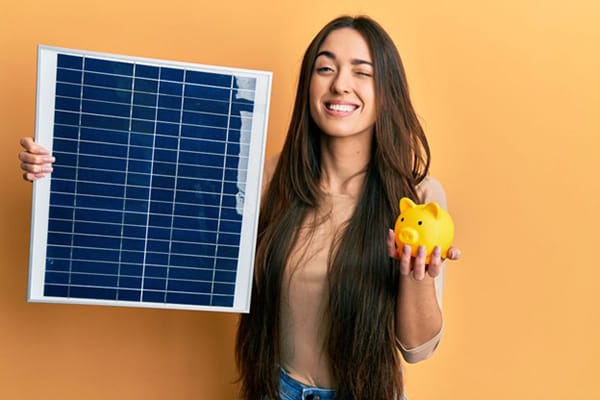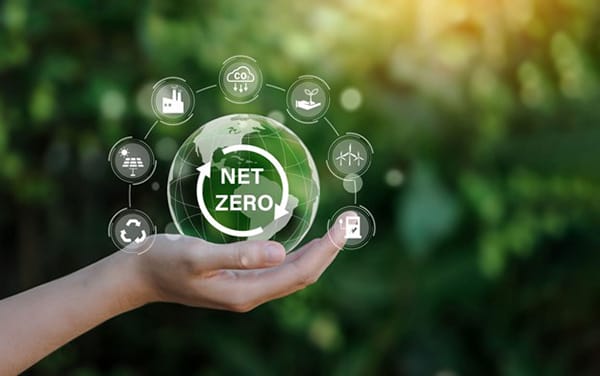Solar power is undergoing a boom in the United States. On average, solar generation capacity has grown by a third in every year of the past decade. The country has 140 gigawatts (GW) of solar capacity, enough to provide renewable energy to over 25 million homes. What’s more, the cost of solar installation has dropped by over two-thirds since 2014, making solar power — and solar buyback programs — more affordable and prominent.
Solar buyback gives the impression that anyone can install solar panels, generate electricity, and start to earn money from their electric company. But is it that simple? Let’s do a deeper dive into what solar buyback is all about and what it can mean for the environment and your bottom line.
What Is a Solar Buyback Plan?
At its simplest, a solar buyback plan is when electric companies pay or give people bill credits for excess electricity they generate from solar panels on their properties. Every energy plan is different, meaning there are varying buyback rates for surplus electricity.
Power companies require solar owners to have smart meters in their properties so surplus generation can be recorded accurately. Savings and credits are added to a homeowner’s electricity bill. Around 20-40% of a household’s solar panel’s electricity production will feed back into the power grid.
How Do Solar Panels Work?
The sun is the largest object in our solar system. It will exist for millions of years, making it a precious renewable energy source.
We capture the sun’s electromagnetic energy through solar panels. They absorb sunlight and convert it into electrical energy through photovoltaic (PV) panels. This energy can be used immediately, stored in batteries or thermal energy, or pushed back into the power grid.
Solar panels produce the most electricity during the day when many people are away from home. Houses with solar panels but no battery storage will generate electricity that can’t be used. That’s where solar buyback plans step in and try to make the most of that clean energy.
How Do I Set up a Solar Buyback Program?
Traditionally, before household renewable energy systems appeared, people drew electricity from the power grid. Electric companies, also called retail electricity providers (REPs) in Texas, metered the inflow and charged their customers.
Micro renewable energy systems like solar panels and smart meters changed how we use our energy resources. People’s homes became mini power stations, able to create energy for domestic use. Importantly, any excess power could be exported back to the grid.
Solar buyback programs reward homeowners with a credit that helps reduce their energy bills. Those lower electricity bills also act as an incentive to install solar panels. However, it’s not just a case of putting some solar panels on your roof and waiting for a paycheck.
Utilities, called Transmission and Distribution Service Providers (TDUs) in Texas, have to ensure your excess energy can flow safely into the power grid. Homeowners must obtain an Interconnection Agreement that declares their home generation system safe. Only once a homeowner receives clearance to operate can surplus electricity be eligible for solar buyback plans.
How Do Solar Buyback Programs Work?
There are two key types of solar buyback: net metering and solar buyback. Note that almost all plans involve bill credits or rebates rather than paying out actual cash.
Net metering involves a simple equation. First, your utility company measures how much electricity you use in kilowatt-hours (kW). Let’s say it’s 1,000 kWh a month since that’s the average.
Next, they take your electricity generation from solar panels, for example, 500 kWh a month. Your generation amount is subtracted from your overall energy usage. Your net usage, or net metering, is 1,000 kWh – 500 kWh = 500 kWh.
Net metering energy rates are usually the same for what you generate and use. If your energy rate was 20 cents per kWh, your monthly usage in our example would be $200, the panels generated $100 of energy, and the final energy bill was $100. There may be fees to connect to the power grid.
Solar buyback works slightly differently — the amount you pay for electricity and the amount you are paid for generating electricity are different.
Using our same 1,000 kWh monthly amount, you may pay 20 cents per kWh for the energy you use but receive 8 cents for what you put back into the grid.
Enter your ZIP Code and compare electricity rates
Your usage bill would be $200 minus $40 for the solar buyback, meaning the bill would be $160 that month.
Of course, in one month, you may produce more electricity than you use. Some solar buyback deals will allow you to roll over that credit to the next month, while others won’t. As with all electricity plans in Texas, always read the Electricity Facts Label for the details.
How Much Money Can Solar Buyback Make Me?
Solar buyback may not make you much hard cash, but it can save you lots of money on energy bills over the long term. Let’s look at the costs.
In the United States, the average household solar energy system installation costs between $16,500 and $20,100 (February 2023).
In 2021 in Texas, the average residential electricity bill was $132.40, or $1,588 a year, using 1,094 kWh annually.
Savings estimates range to $1,500 yearly, depending on the system and your energy usage. Therefore, the savings could take a while to pay for the initial investment. After that, the savings begin.
Indeed, one study suggested that homeowners that install solar panels can save around $19,000 over their 30-year lifetime. People can also apply for help with solar panel installation costs.
What Is a Good Payback for Solar?
Solar energy systems vary from household to household. Each property has different attributes that affect its ability to produce solar energy. These include:
- Roof angle and direction
- The direction your house faces
- Local climate and average hours of sunshine
- Any overhanging trees or obstructions to the panels
- Number, type, and quality of solar panels installed
Solar panels represent a significant investment. The energy and bill savings after their installation take an average of 8.7 years to reach payback. The typical payback period is 6-10 years. Most solar panels last 25 years or longer, prolonging their payback period.
Are There Tax Credits for Installing Solar Panels?
Federal and state governments offer help to homeowners installing solar panels.
The federal solar tax credit offers a 30% tax credit to people installing solar PV systems between 2022-2032. This credit decreases to 26% in 2023, then 22% in 2034, with the plan expiring in 2035.
Texas is the second-biggest solar power producer in the United States. The good news for anyone considering installing solar panels is that no Property Owners’ Associations, also known as Homeowners’ Associations or HOAs, can stop you.
The Lone Star state support tends to be at a local level. For example, Austin residents can apply for a $2,500 rebate from Austin Energy for installing solar PV panels on their homes.
Are There Solar Buyback Programs in Texas?
Texas has a deregulated energy market, meaning around 85% of residents can shop around for electricity plans.
Not every electric company or utility offers solar buyback programs. Shop around using price comparison websites, and check with your electric company and utility for their incentives.
Remember to contact your Transmission and Distribution Utilities (TDUs), or utilities, to see if they offer solar buyback. The principal TDUs are:
- TNMP: Lewisville, Pilot Point, Leonard, and Glen Rose
- Oncor: Dallas, Fort Worth, and Arlington
- AEP Texas: Abilene and Corpus Christi
- CenterPoint Energy: Houston
Can I Lease Solar Panels for My Home?
Renters or those who cannot afford to buy solar panels can lease them. The average cost of leasing solar panels is anywhere between $50-250 per month in the United States, depending on the configuration. They can save money on your utility bills, but be sure to check potential energy bill savings before installing them.
Most importantly, find out what happens when you move. Some companies charge to remove or move leased solar panels or charge a fee to end the lease contract early. Also, keep in mind that people leasing solar panels don’t qualify for tax credits or state aid programs.
Do Solar Panels Reduce Carbon Emissions?
Of course, many people install solar panels to reduce their greenhouse gas emissions as much as to save on energy bills. Sunlight is free and doesn’t cause any pollution itself, unlike burning fossil fuels like coal or natural gas.
Manufacturing, recycling, and disposing of solar panels do create carbon emissions. However, it’s estimated that a home reduces its electricity carbon footprint by around 80% after installing a solar energy system.
Part of the United States federal plan to reach net-zero emissions by 2050 includes providing 40% of the nation’s electricity requirements by 2035. The aim is to install 20 times today’s solar-power electricity generation by 2050, some 3,000 GW of electricity annually.
Quick Checklist for Solar Buyback Plans
These are the main points to consider before buying solar panels with a view to opting into solar buyback programs:
- Determine if your home is suitable for solar panel installation.
- Ask installers to assess how many kWh of electricity your panels could generate each month, considering seasonal variations.
- Work out your monthly and annual electricity usage in kWh.
- Look into federal and state tax credits or rebates to help with installation costs.
- Contact your electric company and utility to see what solar buyback plans they offer.
- Those in Texas’ deregulated energy market areas can shop for other companies offering solar buyback options.
Making the Most of Solar Buyback Programs
Solar power and home solar energy systems are on the rise. Nowadays, solar PV panels are a common site, from solar farms to micro-generation plans on people’s home and business properties.
However, many people are away from their properties when their solar panels work optimally. If this excess energy isn’t stored in a battery, it can go to waste. Utilizing every kilowatt of renewable energy is vital in the battle against climate change.
That’s where solar buyback plans step in. Households can push the excess energy created by their solar panels into the grid, acting like mini power plants. Houses nearby use this locally produced electricity instead of getting it from power stations, possibly via fossil fuels.
Electric companies reward people supporting the power grid by offering bill credits or rebates on energy bills. These so-called solar buyback programs can help people save money on energy bills. Most financial incentives help homeowners, but renters can also lease solar panels to get in on the act.
The world is beginning its solar revolution. While you’re thinking over whether your home can go solar, why not try some solar-powered outdoor lights to illuminate your garden, yard, or home exterior?
It’s an enchanting thought: we can use the sun’s power to bring light to darkness — and possibly even save us money while doing it.
Brought to you by energysavings.com
All images licensed from Adobe Stock.
Featured image:





